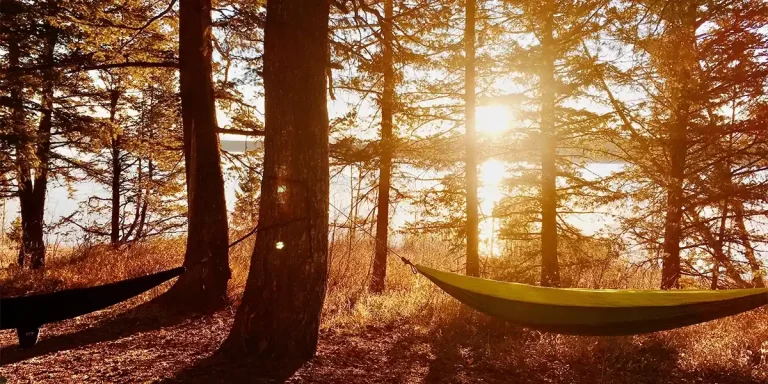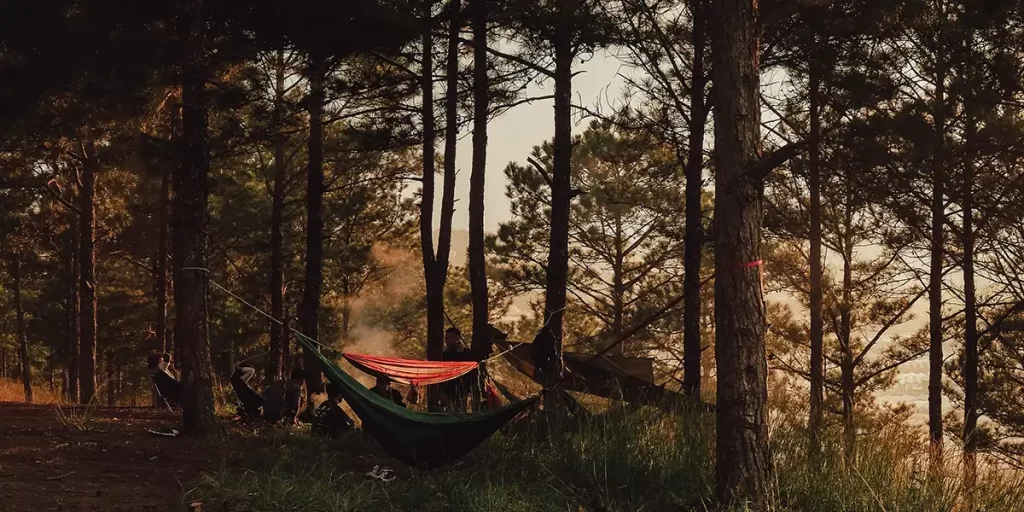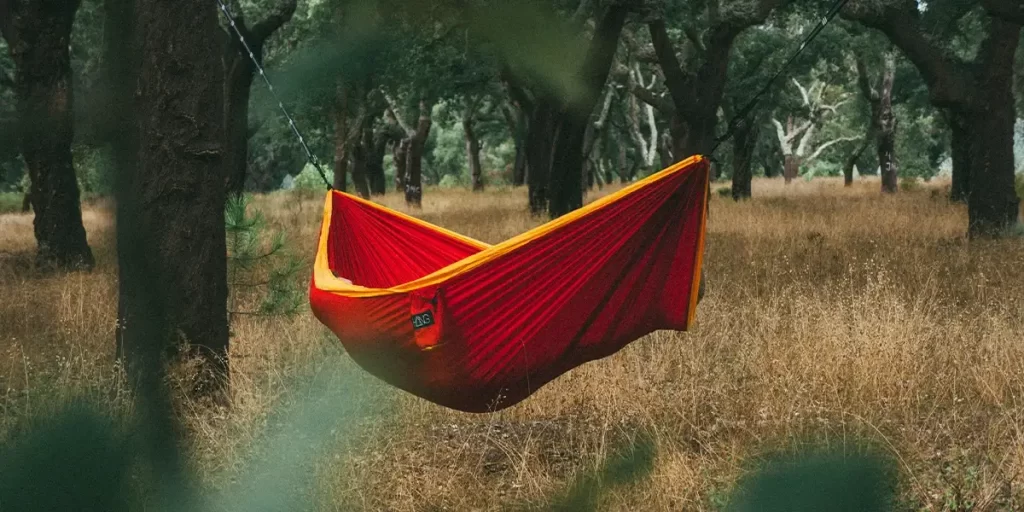

Thinking about getting a hammock for your next camping or backpacking trip but feeling overwhelmed by all the options? You’re not alone – choosing the right hammock can be a daunting task.
This post will guide you through how to choose a hammock. With various material types, weight limits, and extra features to consider, it’s easy to get lost in the ocean of specifications.
Intrigued? Excellent. Let’s begin.

Hammocks were originally used for sleeping and relaxation by ancient cultures in South and Central America. Today, backpacking hammocks provide a comfortable way to sleep above the chilly ground.
Complete hammock sets (also known as hammock tents), which come with all the necessary accessories for enjoying your backpacking trip, have comparable weights to ultralight tents. However, hammocks provide some key advantages for the ultralight backpacker:
But before we can help you choose the ideal hammock, it’s important to understand them in more detail. So let’s continue.
Choosing the right type for your backpacking hammock is crucial. There are two main options
1. Single Hammocks:

These are about 4 to 5 feet wide (1.2 to 1.5 meters), making them lightweight and compact. Ideal for solo adventurers, they save on weight and space in your backpack but offer less room for lounging. Weight limits for singles typically range from 300 to 400 pounds (136 to 181 kg), with ultralight versions around 200 pounds (90 kg).
2. Double Hammocks:

Wider at 5 to 6 feet (1.5 to 1.8 meters), these hammocks provide more space for a comfy sleeping experience. Many solo backpackers prefer them for added room. Doubles support 400 to 500 pounds (181 to 227 kg), with ultralight models around 350 pounds (159 kg).
The material of your future hammock is crucial for weight and durability. Modern backpacking hammocks use two main materials – nylon and polyester. Here’s what you need to know:
When it comes to materials, you also have to understand the denier rating. This refers to the thickness of the fabric threads. A higher denier rating means more durability but also more weight.
For example, a hammock might use 70-denier fabric for robust models and 30-denier for lightweight versions. Lower denier fabrics are lighter but may wear out faster with rough use.
Certain accessories can enhance your backpacking hammock and help create a fully-featured setup. Here are some recommended add-ons:
Carefully choosing these hammock accessories will help build a complete and comfortable portable shelter for backcountry trips.

Congratulations on reaching this point. By now, you know about the two types of hammocks (single and double), the materials they’re made of, and the essential accessories for your hammock tent setup.
When selecting a hammock, keep these key factors in mind:
For most, we recommend a complete, preassembled ultralight hammock tent to avoid confusion as you begin hammock camping. Check our TOP 5 guide for the lightest recommendations here.
In conclusion, selecting the right hammock for your backpacking adventure is a crucial decision that hinges on your preferences and priorities.
Whether you prioritize lightweight ease of travel or ultimate comfort, understanding factors like size, material, and accessories will guide you to the perfect choice.
Remember, the ideal hammock is the one that complements your backpacking style, ensuring a comfortable and enjoyable outdoor experience. Happy hammocking!
Interested in an ultralight hammock tent? Check out our TOP 5 guide for the lightest options available.
Hammocks can be a good option for backpacking, offering lightweight and compact shelter alternatives. They are especially suitable for areas with trees where you can hang them easily. However, it’s important to consider factors like weather conditions, comfort, and the availability of suitable hanging points when deciding if a hammock is a good choice for your backpacking trip.
When selecting a hammock, it’s important to consider both the length and width to ensure a comfortable fit. Ideal hammock lengths range from 9-11 feet long and widths are 4-6 feet wide. This allows enough room to fully lie down without sagging, which can put pressure on your back and cause discomfort. Look for a hammock length that is at least 2 feet longer than your height to account for sagging when you enter. The width should be sufficient so you don’t feel squeezed from the sides. Trying out hammocks in person at outdoor stores can help you gauge the right dimensions based on your body type and sleeping position. Reading customer reviews online is also useful for finding real-world feedback on hammock sizing and comfort.
Sleeping in a hammock can be colder than sleeping in a tent, as hammocks expose more surface area to the surrounding air, making it easier for cold air to reach you. However, you can mitigate the cold by using insulation such as an underquilt or sleeping pad in the hammock, which helps retain warmth and provides a comfortable sleeping experience.
When choosing an outdoor hammock, nylon and polyester are the most common and recommended fabric options. Nylon is lightweight and breathable, but less durable over time. Polyester is heavier and more long-lasting, standing up to sun, moisture and abrasion. For occasional use in mild climates, nylon provides an optimal blend of comfort and packability. For extended outdoor use and extreme conditions, polyester is more rugged and weather-resistant. The threads that make up these fabrics also come in varying densities, described in denier ratings. Higher denier nylon and polyester last longer but are bulkier. Lower denier saves weight at the cost of lifespan
A quality suspension system is crucial for safely and easily hanging your hammock. The best options are wide tree straps made from durable nylon or polyester webbing. Look for straps that are at least 2 inches wide to prevent damage to trees. The material should have ample strength to hold weight. Straps often connect via carabiners or toggles to ends of rope or woven straps on the hammock. Adjustable buckle systems allow customizing the hang angle and tension. Some hammocks come with integrated suspension, but stand-alone straps offer more flexibility. Choose straps with plenty of length to accommodate various distances between anchor points. Prioritize high-strength, tree-friendly straps that make setup straightforward and provide a secure, comfortable hang for your hammock.
When choosing a hammock for backpacking and camping, opt for optimal colors like neutral earth tones such as green, brown, tan, and grey shades, or a camouflage design. These colors help the hammock visually blend into natural surroundings, keeping your camping low-impact while providing privacy and security when sleeping outdoors. While bright colors like red or yellow may look nice in a backyard, they can attract unwanted attention on the trail. Darker muted solids and or a camo pattern can also hide dirt better after long hikes.